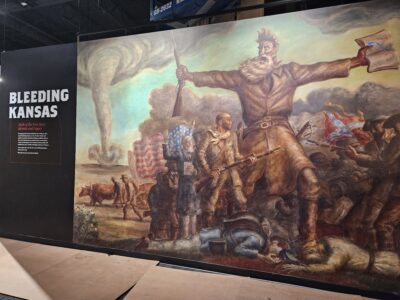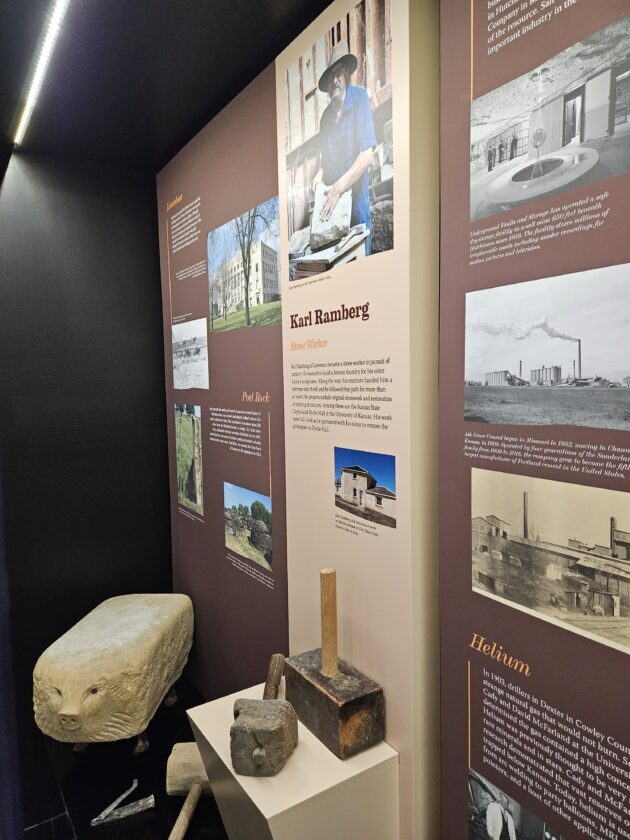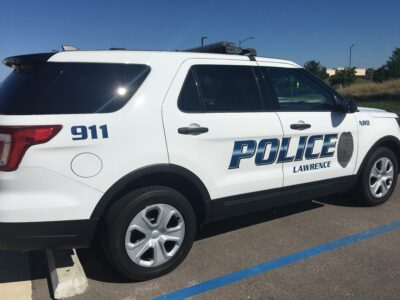Lawrence stone carver’s story will be one of many new exhibits at revamped Kansas Museum of History in Topeka

photo by: Contributed Photo
The Bleeding Kansas section of the Kansas Museum of History has been revamped, along with the rest of the museum's galleries.
When the Kansas Museum of History in Topeka opens its new galleries on Saturday, Lawrence stone carver Karl Ramberg is excited to see some of his own history on display – well-worn mallets used by him and two of his mentors.
“I donated the one that my teacher, Elden Tefft, gave me, but also the one that his teacher, Bernard ‘Poco’ Frazier, Frazier’s family had given me,” he said of his recent contribution to the museum, which will be in an exhibit on Kansas’ natural resources. “And then I donated one of my wood mallets.”
“And so I kind of show the lineage of teacher to student, when that person becomes the teacher and the next person, you know, and how it’s passed on.”
These three artists’ work can be seen in many places in Lawrence – Tefft is known for bronze sculptures such as the 10-foot-tall Moses statue in front of KU’s Smith Hall and and the Jayhawk in front of Strong Hall; Frazier’s bas-reliefs are above the doors of Lindley Hall at KU; and if you look up on Jayhawk Boulevard you can see Ramberg’s grotesques gazing out from their perches on Dyche Hall.
And the tools they used, museum director Sarah Bell said, are “a huge acquisition” for the museum, which has been closed for renovations since September 2022.
“You can tell, particularly with the Poco Frazier ones but I believe Elden Tefft too, how well-used they are,” she said.

photo by: Contributed Photo
An exhibit at the Kansas Museum of History features mallets donated by stone carver Karl Ramberg, of Lawrence.
Though they may feature these stoneworkers’ stories, the museum’s new galleries are meant to show that history isn’t just old things carved in stone. Bell said the old gallery organization where exhibits were structured chronologically – “from about 13,000 years ago all the way up to, quote, ‘our recent past,’ which featured artifacts and stories from the 1940s through the 1980s,” – had gotten “a little bit outdated.”
Now, she said, they’ve been reorganized so that each gallery is about a “core theme” of Kansas history. That includes not only Kansas’ role in the 19th-century struggle over slavery, but also the state’s natural resources and industries; the impact of the railroad; and a gallery called “Changing Kansas,” which, among other things, looks at how the state has played a key role in social reform movements throughout its history – “everything from populism to Prohibition, women’s rights, civil rights and more.”
Some favorites of the old museum are still there, like the oldest surviving Atchison, Topeka & Santa Fe locomotive.
“The train is still here – that’s a question we get asked a lot,” Bell said.
But expect plenty of new things, too, including an exhibit on the Sunflower Showdown rivalry between the University of Kansas and Kansas State University.
The KU-Mizzou rivalry is there, too, of course – but it’s actually addressed in the gallery on the much more violent border war between proslavery and antislavery forces.
The Bleeding Kansas gallery will take a different approach to telling one of Kansas’ most well-known stories, said Bell, who lives in Lawrence and previously worked at the Watkins Museum of History. In particular, she said, it will focus more on the human aspect of the conflict, including the roles of people and institutions with ties to Lawrence and Douglas County. She mentioned Julia Louisa Lovejoy, who documented the struggle between pro- and antislavery forces in her letters, and the Kansas Herald of Freedom, the weekly Free State newspaper.
“Even for those folks who are like, ‘I know the story,’ they’re going to enjoy the way we are telling it, because it’s kind of from a different, really people-oriented perspective first before we dive into the timeline,” she said.
Ramberg has actually worked with that human history before. A few years ago, he said, he was called on to create a reproduction of a headstone that once marked a grave in Pioneer Cemetery of someone who died in the 1856 sack of Lawrence.
“KU Endowment wanted me to carve a replica because that original tombstone was part of the Kansas history museum collection,” he said. It was inscribed with an abolitionist message, Ramberg said, something to the effect of, “I’m proud to give my life for the cause of freedom in Kansas.” He worked with the museum to take the measurements of the original so he could create that replica to put in the cemetery.
Just this week, Ramberg was at the museum to help put the finishing touches on another exhibit, installing some stone fencing on the museum’s concrete floor. He had hoped to see the exhibit that he was featured in, too, but it wasn’t finished yet.
“I’m real curious,” he said. “I was hoping they’d have the exhibit up.”
He’ll get the chance to see it at Saturday’s opening. The museum is at 6425 SW Sixth Ave. in Topeka, and its doors will open at 9 a.m., with a ribbon-cutting ceremony scheduled for 9:30 a.m.
Those who attend might even see Ramberg there, as well as Lawrence artist Stan Herd, whose new mural will be featured in the galleries.
Even if you can’t make it out this weekend, admission to the museum will be free through the end of the year.
“It’s such an honor for me,” Ramberg said of his collaborations with the museum. Then, he quipped, “But it also makes me think that, ‘Oh, if you’re in the history museum, maybe that means you’re old!'”
Then, on a more serious note, he added: “The museum is such a great place.”
That’s what I want (people) to hear more than anything, you know,” he said. “It’s a wonderful institution.”

photo by: Contributed Photo
The Sunflower Showdown is highlighted in the new galleries at the Kansas Museum of History.






